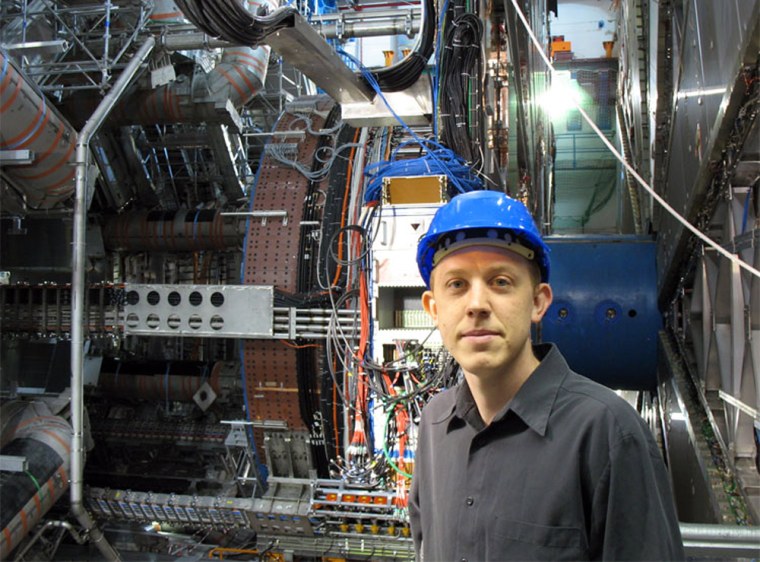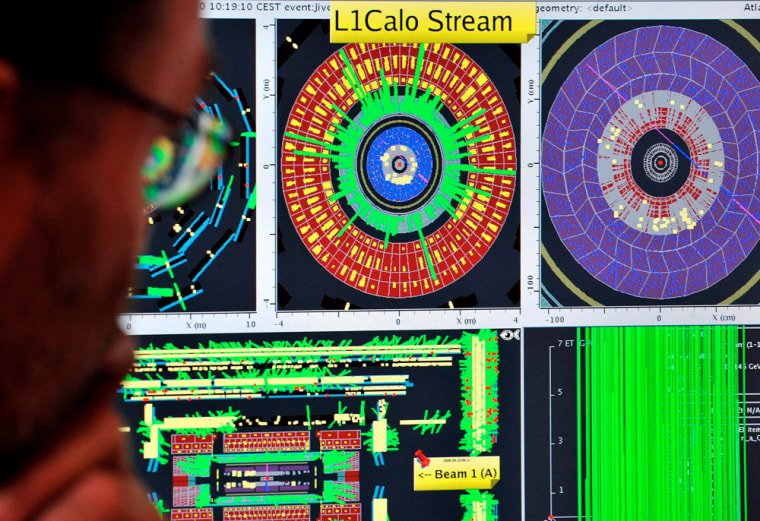Adam Yurkewicz was born, raised and schooled in New York state, intending to become an engineer. But in 1996, during his junior year in college, he got hooked on quantum electrodynamics and other wild ideas from the frontiers of physics — and he's never been the same since.
To follow his vocation as a particle physicist, Yurkewicz has been a grad student in Michigan, an experimenter in Illinois, a postdoctoral researcher in New York, and other things in between. He is now working on the ATLAS experiment at the Large Hadron Collider, and living in France with his New York-born wife and their first child.
In short, Yurkewicz is a science nomad.
"I don't think I've lived in the same place for more than a year in the last 10," he said as he sat at a table outside the cafeteria at Europe's CERN particle-physics center, just outside Geneva.
There are a lot of brainy nomads hanging around CERN's cafeteria nowadays. The patrons hail from all over the United States, from Canada, from Russia, from Japan, from China, and of course from across Europe. "It's like a mini-U.N.," Yurkewicz said.
Changing of the guard
The buzz of activity at CERN's Swiss campus dramatically illustrates a changing of the guard on the frontier of physics, with Europe taking over from the United States. For the past 14 years, Europeans have taken the lead role in building and financing the $10 billion Large Hadron Collider, which was started up on Wednesday. The U.S. federal government kicked in $531 million for construction.
The LHC is just this week's most obvious example of Eurocentrism in science: Less than 200 miles (300 kilometers) away, an even costlier international physics project, the $13 billion ITER fusion research center, is just getting started in southern France. And European officials are currently considering how to move forward with yet another fusion project, the $1 billion HiPER laser-fusion facility.
Meanwhile, in the United States, physicists were shocked last December to see Congress pull back on research spending, to the tune of $94 million. Financial support for ITER was virtually wiped out. It took months for some of that money to be restored in a supplemental funding bill — and while Congress dithered, scores of research positions were lost.
For decades, American know-how has benefited mightily from a "brain drain" of talent from Europe. It started in earnest when German physicist Albert Einstein and many of his colleagues fled the Nazi threat in Europe in the 1930s and relocated in the United States. That flow of expertise continued right through the space effort of the 1960s and '70s as well as the telecommunications revolution of the '80s and '90s.

Today, the United States still ranks No. 1 in most science and engineering indicators, but recent figures from the National Science Foundation indicate that the U.S. lead is eroding. And it doesn't take a Ph.D. to figure out that when it comes to cutting-edge physics, all roads are currently leading to Europe.
Michio Kaku, a widely known author and theoretical physicist at the City College of New York, traces the reversal of fortunes back to the cancellation of the Superconducting Super Collider project in Texas.
"Let's be blunt about this: There could be a brain drain of some of our finest minds to Europe, because that's where the action is," Kaku said. "We had our chance, but Congress canceled our supercollider back in 1994. We're out of the picture. We can basically tag along after the Europeans, begging them for time on their machine — but really, the action is in Europe now."
Dutch physicist Jos Engelen, CERN's deputy director general and chief scientific officer, pretty much agrees with Kaku.
"People now talk of an inverse brain drain," he said. "That is, on these projects, our American colleagues have no difficulty finding other American colleagues who want to join us."
Engelen's boss, CERN Director General Robert Aymar, put it even more starkly during a news conference after Wednesday's startup: "Whatever happened, the competition was won by CERN."
The scientific spotlight's shift to Europe raises a dilemma for Yurkewicz and his wife, Katie, a physicist who works in CERN's communication office. For the sake of their 6-month-old son and their families back home, they'd love to move back to the United States when Adam's postdoctoral stint ends next year. But they both realize their job prospects are a lot better if they stay at CERN.
"Whether I'd want to stay ... I haven't decided on that yet," Adam Yurkewicz said a couple of months ago. "Right now, it looks like a big advantage to be here."
Commuters with computers
Not all of the 10,000-plus people involved in the LHC project are full-time residents like Yurkewicz. Most researchers spend just a few weeks at a time at CERN — checking in on their experiments (with graduate students in tow), then returning to their labs and classrooms back home.
"It's almost like commuting for those of us on the short term," said Karl Ecklund, a physics professor at the University of Buffalo who is part of the team behind the LHC's Compact Muon Solenoid detector, or CMS for short.
Another way that the LHC's researchers can be involved in the experiments without being there is to plug in through videoconferencing. Even before the final push to the collider's startup, it was difficult to reserve a spot for video linkups during the afternoons in CERN, which correspond with the morning's working hours in the United States.
Once the collider has been up and running for a while, some of the maintenance duties could be shifted thousands of miles away, thanks to high-speed network links that connect the control rooms at CERN with remote operations centers around the world.
"A lot of the shift work is just watching things. ... Shifting it to the U.S. is just a question of bandwidth," said Fermilab's Joel Butler, head of the US-CMS Research Program. "I don't imagine the're going to let you 'drive' the lab, but you can at least read the map and tell what's going on."
Nevertheless, virtual reality has its limits — particularly now, when the multibillion-dollar machine's kinks have to be ironed out. "There's nothing like being there," Ecklund said.
The next big thing
Is the Large Hadron Collider a model for big science projects to come, or will it turn out to be the last of the big-science dinosaurs? Nearly everyone involved in the project says that the expense and the complexity required for doing grand scientific experiments have become greater than any one country could manage alone.
"Each facility of this scale is going to exist in one place in the world," Butler said.
So who decides how and where big science projects will be conducted? In the case of the Large Hadron Collider, CERN went ahead with its plan, and other nations gradually signed on. A slightly different model came into play for the ITER fusion project — which is being organized and funded by Europe's atomic energy agency and six other nations, including the United States.
The concept behind ITER goes back to the Reagan-Gorbachev summits of the 1980s, but it took years of political machinations to nail down the details. Finally, in 2005, the partners struck a compromise that put ITER's research reactor in France and another research center in Japan. ITER's structure calls upon each of the partners to provide hardware according to a complicated formula, leading up to the scheduled start of operations in 2016.
Aymar, a French physicist who headed up the ITER project before he took on CERN's top job, is intimately familiar with both approaches. He said CERN can take advantage of a huge head start in future international science projects, just because it's been doing it successfully for more than 50 years.
"To start from zero ... I don't recommend for any international body just to start," Aymar said. "It's very, very difficult, because you have to provide everything, with no background."
Long-term and short-term futures
That doesn't mean CERN has a lock on the next Big Bang Machine. The United States and other nations are also interested in at least a piece of the action. That includes the rising stars in science and technology, such as China and India. Just last year, Beijing hosted an exploratory meeting for designing the International Linear Collider, the particle-physics project regarded as the successor to the LHC.
The ILC won't be built until sometime in the next decade — if it's built at all. That depends on whether the LHC is successful, and whether governments ultimately decide that the ILC's estimated $6.7 billion cost (or whatever the full cost turns out to be) is worth it.
The amount of money and political will for doing grand physics projects is clearly limited, said physicist Barry Barish, director of the ILC's Global Design Effort. He estimated that the international community would be willing to fund a $5 billion to $10 billion international project every 10 to 20 years.
"Obviously, we can do one every one or two decades, and that's it, because of the cost," he said this year at a scientific conference. "So we have to do the right one."
Does cutting-edge physics really have to cost so much? Lawrence Krauss, a theoretical physicist at Case Western Reserve University, said many people assume that physicists get together and ask themselves, "How can we come up with something that costs the most?" But Krauss argued that the reality was exactly the opposite.
"If you want to do the challenge of fusion, if you want to understand the early universe or the fundamental structure of matter, there's just no other way. This is the least amount you can spend," Krauss said. "You just have to decide if it's worth it."
For Yurkewicz and thousands of other physicists, it's worth it — even if they have to journey to a foreign land. It's particularly worth it now, when the Big Bang Machine is starting up.
"The most exciting part of particle physics," he said, "is being in that control room and watching the data come in."
